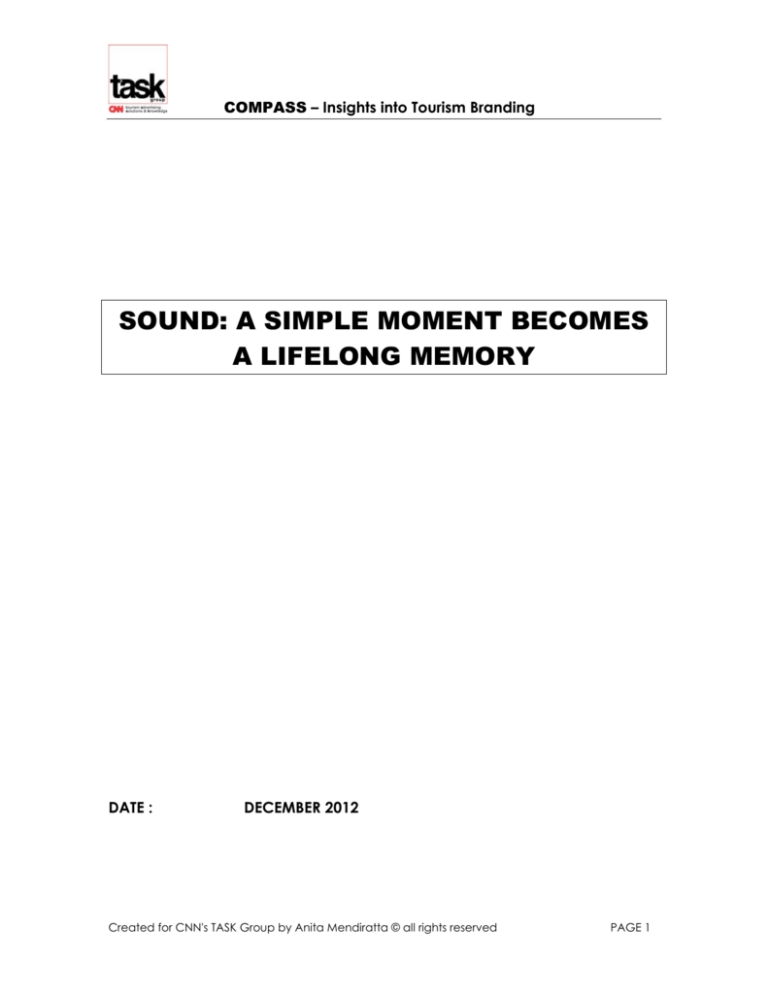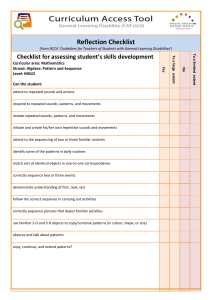
COMPASS – Insights into Tourism Branding
SOUND: A SIMPLE MOMENT BECOMES
A LIFELONG MEMORY
DATE :
DECEMBER 2012
Created for CNN's TASK Group by Anita Mendiratta © all rights reserved
PAGE 1
COMPASS – Insights into Tourism Branding
INVISIBLE IMPACT
Sitting in an outdoor hotel lounge on the banks of the Nile, the midday sun pouring down
on an array of Luxor’s inhabitants and visitors. Tourists of various nations, destinations and
travel aspirations were soaking up the here and now as far as the eye can see. Whether in
town for business or pleasure, carrying cameras or laptop cases, they are taking it all in.
Images, impressions, pieces of a puzzle will come together to create a memory.
And then, suddenly, it happens. The adhan.
In a single second the deep sounds of the call to prayer fill the air. For the tourists scattered
along the banks, it was as though the air had thickened. The sounds emanating from the
nearby mosque began to blend together all of the sights and thoughts being absorbed in
an almost sensory glue-like fashion, making the here and now more penetrating, more
personal, more paused.
Suddenly, all feels still. The visitors may not understand the words of the calling, but the
feeling was undeniable. It is as if the moment, the sound, the stillness, was connecting
them all.
Within seconds the pause button is released. The tourists return to their cameras and
laptops. But something is different, subtly. The remotest, slightest smiles are evident on their
faces. The connection to the place has been made, their memories have been tied in an
audio bow. Wherever they may be in the world in the future, the sound of the adhan will
take them right back to the Nile - to that moment, to that feeling.
For travellers, unique, local sounds have an even greater impact on the brain’s capture of
memories. In a split second the re-hearing of a certain word, a certain chord of music, a
certain command, a sound can take a person back to a place visited.
SENSE OF SOUND – YOU ARE HERE
The sense of sound, one of the most deeply penetrating senses in minds and hearts, is,
however, often overlooked as a means of embedding a sense of place to the traveller
experience. While often not consciously acknowledged, the human memory bank soaks it
up, with its detail of when, where and even why. When it is present and unique to the
place, it creates a remarkable sense of orientation and connection.
Sensory immersion into a new place occurs at many levels. What we see, what we hear,
what we touch, what we taste, what we smell - ultimately what we feel - all matter as
vehicles that play a part in making sense of the here and now.
Of all of the senses, sound is one of the most powerful channels through which a sense of
place, and its memories, are embedded in our minds, and hearts.
Technically speaking, it is called ‘echoic memory’ – a sensory memory that captures and
retains auditory information. Sound is absorbed and processed, creating impressions. This
auditory information - these impressions - can remain in our memories long after their first
moments of creation. The reoccurrence of similar audio stimulus can unlock the original
impression embedded in our memory, taking us back to where we were – and how we
felt.
In the context of travel, when in an unfamiliar place, the human brain takes in and
organises an array of associated details to create a memory. In so doing, a permanent,
mullti-sensory postcard is composed to oneself.
Created for CNN's TASK Group by Anita Mendiratta © all rights reserved
PAGE 2
COMPASS – Insights into Tourism Branding
When absent, it leaves a gap – something is missing. And from a travel experience
perspective, something is lost.
STRIKING THE RIGHT CHORD
For this reason, when a traveler is in a new place, their brain busy re-establishing a local
logic with all of the senses turned up to high, distinctive local sounds can prove invaluable
in accelerating a visitor’s sense of place. And creating a deeply rooted bond to a place.
It can be simple, single moments:
-
arrival into the lobby of a hotel in India and hearing the soft sounds of sitar and
tabla musicions being pumped through the property’s audio system;
-
approaching a conference registration desk at a Hawaiian island resort , hearing
the swaying chords of hula music of the Polynesian Islands filling the warm,
welcoming night air;
-
entering the passport control hall of a South African airport and being greeted by
the Department of Immigration official with a warm “howzit”;
-
readying to board a train on the London Underground and hearing the now iconic
warning “mind the gap”;
-
boarding a flight in Tokyo and noticing the subtle musical sounds of the koto filling
the cabin;
-
approaching the check-in desk at a Texas airport and being welcomed with a
cheerful “howdy!” by the airline representative.
All of these moments, and millions more, become opportunities for the creation of a
memory that cements an almost tactile sense of place, space and mood.
For destinations offering culture as a pillar of their experience, the sense of sound should
be embraced as a vital part of fulfillment of the experience promise. To leave out
distinctive, signature sounds in a traveller experience is to deprive a visitor of a holistic,
emotionally heart-filling opportunity.
As explained by Dr Sunita Goel, M.D., C.C.F.P.:
“Employing our sense of sound can shape a memory trace, which can then be
utilized to stimulate the brain cortex to elicit a response when the sound is heard
again. These memory aids trigger our cortex to elicit an emotive response that can
give us the desire to experience it again.”
Yet still, the creation and amplification of distinctive destination sounds and songs is still so
overlooked. Sadly, opportunities lost.
Worst case, generic music, or no sound at all.
Not only does such opaqueness of auditory experience flatten a place, it takes away from
the visitor experience. With greatest respect to the artists and establishments, there is no
reason to have the sounds of:
-
Kenny G’s saxophone floating through the high ceiling, marble inlayed, dining
rooms of classic heritage hotels in Turkey;
Created for CNN's TASK Group by Anita Mendiratta © all rights reserved
PAGE 3
COMPASS – Insights into Tourism Branding
-
Birds chirping alongside babbling brooks in an Ayurdevic spa in India; or
-
‘Jingle Bell Rock’ piped through the terminals of Spanish airports in the lead-in to
the Christmas holiday period.
Such deafness to opportunities to create lifelong memories out of simple moments costs
more to the experience than investing thought into what is right for the time, place and
guest’s hopes. It costs the connection.
The sweet anticipation felt by travellers to be immersed in rich, culturally-inspired, exotic
environments must be honoured by those given the blessing of fulfilling these travel
dreams.
The message is loud and clear: the power of sound, especially unique sounds, is profound
– it provides a natural orientation, an often lifelong trigger for recall of memories, an
intuitive message of “you are here.”
-
ENDS –
Created for CNN's TASK Group by Anita Mendiratta © all rights reserved
PAGE 4








